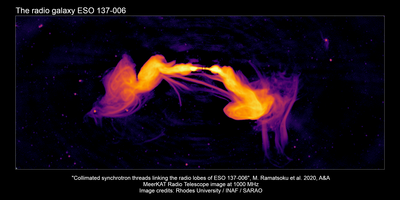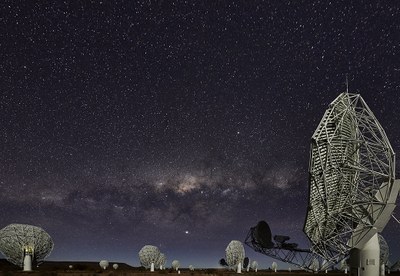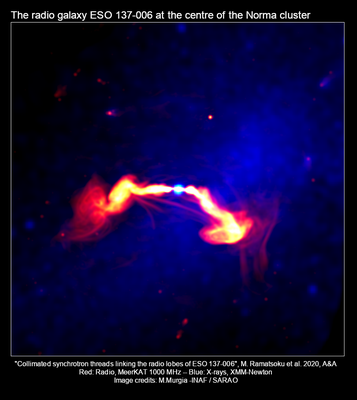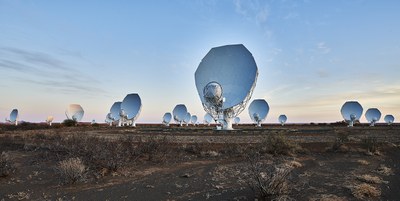Unexpected magnetic channels in a distant galaxy
ESO 137-006 is a fascinating galaxy residing 250 million light-years away from us, in the Norma cluster of galaxies, and one of the brightest objects in the southern sky at radio wavelengths. It is characterised by two very bright and bent lobes of radio emission formed by the active galactic nucleus (AGN) of ESO 137-006, which hosts a growing super-massive black hole at its centre. “New features have been uncovered in this galaxy in the form of multiple, extremely collimated threads of radio emission connecting the lobes of the galaxy,” explained the lead author of the study, Mpati Ramatsoku, a Research Fellow at Rhodes University and Associate at INAF, the Italian National Institute for Astrophysics.
 |
|---|
| Picture also available without caption |
The newly discovered features are providing astronomers with fascinating new insights into the radio galaxy phenomenon. "We were surprised to observe such collimated threads, as these were totally unexpected from what we knew about this class of radio-loud AGNs", said Matteo Murgia a co-author of the study from the INAF - Cagliari Astronomical Observatory. “The properties of these stunning threads are of challenging interpretation. Their emission is likely synchrotron radiation, where radio waves are produced by high-energy electrons spiralling in a magnetic field. These new synchrotron threads show that the radio lobes of radio-loud AGNs could be magnetically connected and that particles could flow into these magnetic channels. However, at present, we have no idea why and when these threads formed nor why they are so collimated and uniform.”
Understanding the nature and the physics of the collimated synchrotron threads (CST) discovered as part of this collaboration could open a new science case for the next generation of sensitive radio interferometers like the SKA and, overall, the next generation on young astronomers involved in solving the great questions already open about our Universe.
 |
|---|
| The MeerKAT array in South Africa. Credits: INAF/Enrico Sacchetti |
This exciting discovery is the most recent result of the prolific collaboration — partly funded by the European Research Council — between astronomers at INAF, the Rhodes University and the South African Radio Astronomy Observatory (SARAO) which operates MeerKAT. This 64-telescope array was launched in 2018 as a precursor of the Square Kilometre Array, which will be built both in South Africa and Australia in the coming years and involves to date more than 100 organisations in 20 countries, all working together on the biggest project of radio astronomy ever undertaken.
Scientific paper:






